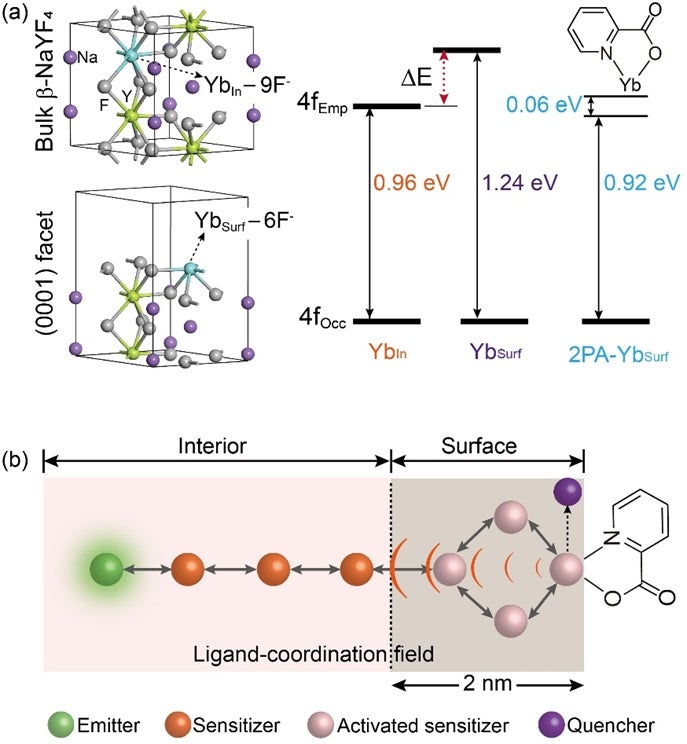Molecule-mediated surface reconstruction enables giant upconversion luminescence enhancement
LIU Xiaogang (Group Leader, Chemistry) September 20, 2021NUS researchers have developed a synthetic method to enhance upconversion luminescence in protein-sized lanthanide-doped nanocrystals by surface reconstruction through molecule coordination. This innovation prevents surface-associated energy loss and marks a significant breakthrough in the field of lanthanide luminescence.
Nonlinear frequency upconversion is a subject of fundamental and technological importance in a plethora of research fields, ranging from materials science, chemistry to photophysics and biology. This interest is driven by versatile applications, including three-dimensional displays, solid-state lasers, optoelectronics, and super-resolution bioimaging, as well as optogenetics. There is a high demand for preparing highly luminescent, protein-sized upconversion nanocrystals, which offers great opportunities for advancing imaging techniques with sub-diffraction-limit resolution. However, for small-sized nanocrystals, a large portion of lanthanide dopants resides on the surface or sub-surface layers, forming a non-luminescent dark layer. Previous studies have reached a consensus that excitation energy loss is dominantly attributed to surface quenching. Despite considerable efforts, the mechanism underlying surface quenching remains elusive, largely due to complex energy diffusion in lanthanide-doped upconversion systems and limited techniques for surface defects characterisation.
A research team led by Prof LIU Xiaogang from Department of Chemistry, National University of Singapore and Prof XU Hui from Heilongjiang University has developed a simple approach to enhance multiphoton upconversion in sub-10 nm crystals by reconstructing orbital hybridization and crystal field splitting in surface lanthanides via ligand coordination. The ligand coordination can activate the sensitizer-containing dark layer and facilitate the energy migration between surface and inner lanthanide sensitizers, enhancing the utility of excitation energy and upconversion efficiency (see Figure). By coordinating with bidentate picolinic acid molecules, NaGdF4:Yb/Tm nanoparticles with diameters of 5 nm have been shown to feature up to 11,000-fold upconversion enhancement in the ultraviolet spectral region. Moreover, ligand coordination can exert energy-level reconstruction with a ligand–sensitizer separation distance of beyond 2 nm. These findings offer new and fundamental insights into interfacial energy transfer in ultra-small systems and provide a platform for constructing optical interrogation systems at single-particle levels.
Prof Liu said, “Our approach has demonstrated a simple and effective strategy for upconversion luminescence enhancement. Molecule coordination neither changes the size and morphology of nanocrystals nor requires complex instrumentation. These bright, ultra-small upconversion nanoparticles hold potential in achieving super-resolution imaging, intraneuronal axon transport tracking, and imaging-guided precision diagnosis at the single-particle level.”

Figure: (a) Schematic illustration of coordination and 4f energy levels of trivalent ytterbium ions residing in the interior (Ybin, top) and surface (Ybsurf, bottom) of a NaYF4 nanoparticle. (b) Diagram showing upconversion luminescence enhancement by ligand coordination. [Credit: Nature Photonics]
Reference:
Xu H*; Han S; Deng R; Su Q; Wei Y; Tang Y; Qin X*; Liu X*, “Anomalous upconversion amplification induced by surface reconstruction in lanthanide sublattices”, NATURE PHOTONICS DOI: https://doi.org/10.1038/s41566-021-00862-3. Published: 2021.


